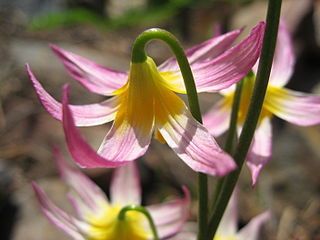
Erythronium purpurascens is a species of flowering plant in the lily family which is known by the common names purple fawn lily and Sierra Nevada fawn lily.

Helianthella californica is a species of flowering plant in the family Asteraceae known by the common name California helianthella. This wildflower is native to the mountains of California, northwestern Nevada, and southwestern Oregon.

Arctostaphylos nevadensis, with the common name pinemat manzanita, is a species of manzanita.

Arnica nevadensis is a North American species of arnica in the sunflower family, known by the common names Nevada arnica and Sierra arnica. It is native to the coniferous forests of the western United States, primarily the Cascades and Sierra Nevada.
Chaenactis alpigena is a species of flowering plant in the daisy family known by the common name southern Sierra pincushion. It is native to the High Sierra Nevada and the White Mountains of California, extending in the latter just into Nevada.

Chaenactis nevadensis, with the common name Nevada dustymaiden, is a North American species of flowering plant in the daisy family.
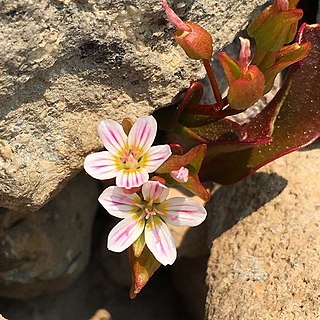
Claytonia nevadensis, known by the common names Sierra springbeauty and Sierra Nevada claytonia, is a species of wildflower in the family Montiaceae. The evolutionary relationship of Claytonia nevadensis to other claytonias is a subject of debate and ongoing genetic studies. Sierra springbeauties are diploid with a chromosome base number of x = 7
Epilobium howellii is an uncommon species of flowering plant in the evening primrose family known by the common names Yuba Pass willowherb and subalpine fireweed. It is endemic to the High Sierra Nevada of California, where it is known from only about 20 occurrences.
Ivesia unguiculata is a species of flowering plant in the rose family known by the common name Yosemite mousetail.

Lewisia nevadensis is a species of flowering plant in the family Montiaceae known by the common name Nevada lewisia. It is native to much of the western United States, where it grows in moist mountain habitat, such as meadows. This is a small perennial herb growing from a taproot and caudex unit. It produces a basal rosette of several narrow, fingerlike to threadlike fleshy leaves up to 13 centimeters long. The inflorescence is a bundle of short stems a few centimeters tall each bearing a flower. The flower has 5 to 10 shiny white to pale pink petals each 1 to 2 centimeters long, pointed or with blunt tips. At the center are many stamens. This is sometimes grown as an ornamental plant suitable for alpine and rock gardens.
Podistera is a genus of flowering plants in the carrot family. The four species are native to western North America, where they grow in high mountains and northern latitudes. They are compact, mat-forming perennial herbs with a low, clumpy habit common among plants growing in harsh, exposed, cold, dry habitat.
Ptilagrostis kingii is a species of grass known by the common names Sierra false needlegrass and King's ricegrass. It is endemic to the high mountains of the Sierra Nevada of California, where it grows in meadows and near streams in subalpine and alpine climates.

Raillardella argentea is a species of flowering plant in the family Asteraceae known by the common name silky raillardella. It is native to the Sierra Nevada and nearby mountain ranges of California, its distribution extending east into Nevada and north along the Cascade Range and Klamath Mountains into Oregon. It grows in many types of dry, open mountain habitat. It is a rhizomatous perennial herb growing in a clump of rosetted basal leaves. The leaves are lance-shaped, up to 8 centimeters long, and coated in silky hairs. The plant produces an inflorescence up to about 15 centimeters tall consisting of a solitary flower head which is cylindrical to somewhat bell-shaped. The head is enclosed in the fused outer scales of the flowers, which look similar to the phyllaries of many other species' flower heads. The head contains many yellow disc florets up to a centimeter long each, and no ray florets. The fruit is a long, narrow achene which may be 2 centimeters in length including its plumelike pappus.

Micranthes aprica is a species of flowering plant known by the common name Sierra saxifrage. It is native to the high mountains of California, including the Sierra Nevada and the southern Cascade Range, and adjacent slopes in southern Oregon and western Nevada. It grows in mountain habitat in areas of alpine climate, such as meadows and next to streams of snowmelt. It is a perennial herb which spends most of the year in a dormant state in order to save water, and rarely flowers. It produces a small gray-green basal rosette of toothed oval leaves up to about 4 centimeters long. When it does bloom, it sends up an erect inflorescence on a peduncle several centimeters tall topped with a cluster of flowers. Each flower has five sepals, five small white petals, and a clump of whiskery stamens at the center.

Silene sargentii is a species of flowering plant in the family Caryophyllaceae known by the common name Sargent's catchfly. It is native to the western United States, where it is known from the mountain ranges straddling the California-Nevada border east of the Sierra Nevada. It is also known from one disjunct occurrence in central Washington. It grows in rocky mountain habitat in subalpine and alpine climates. It is a perennial herb growing from a woody, branching caudex and taproot, sending up several decumbent or erect stems and shoots. It grows no more than about 20 centimeters tall, often taking a clumpy form. The fleshy leaves are widely lance-shaped and a few centimeters in length, most of them occurring around the caudex. Each flower is encapsulated in a hairy, glandular calyx of fused sepals which has stark purple veining. The petals are white to deep pink and each has two or more rounded or pointed lobes at the tip.
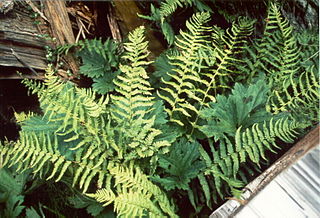
Parathelypteris nevadensis, synonym Thelypteris nevadensis, is a species of fern known by the common names Sierra marsh fern, Sierra wood fern, and Nevada marsh fern. It is native to western North America from British Columbia to the mountains of northern California, where it grows in moist wooded areas, streamsides, meadows, and seeps. It is known from two locations in Idaho, as well. Despite its name it is not found in Nevada, rather, it was named for the Sierra Nevada, where it does occur in the northern mountains. It produces a dense cluster of long, feathery leaves which may be up to a meter long. It is rhizomatous and it sometimes forms colonies. The leaves die back in winter. Each leaf is made up of leaflets lined with smaller segments. The undersides are glandular and resinous and sometimes hairy.
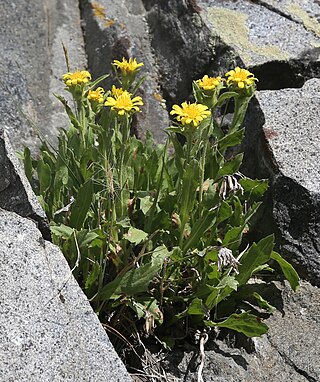
Tonestus peirsonii is a local-endemic species of flowering plant in the aster family known by the common names Inyo tonestus, Peirson's serpentweed and Peirson's tonestus.
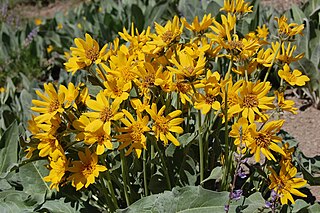
Wyethia mollis is a species of flowering plant in the family Asteraceae known by the common name woolly mule's ears. The plant is hairy to woolly in texture, sometimes losing its hairs with age.

Ericameria parryi is a species of flowering plant in the family Asteraceae known by the common name Parry's rabbitbrush. It is native to much of the western United States.

The flora of the U.S. Sierra Nevada alpine zone is characterized by small, low growing, cushion and mat forming plants that can survive the harsh conditions in the high-altitude alpine zone above the timber line. These flora often occur in alpine fell-fields. The Sierra Nevada alpine zone lacks a dominant plant species that characterizes it, so may or may not be called a vegetation type. But it is found above the subalpine forest, which is the highest in a succession of recognized vegetation types at increasing elevations.














